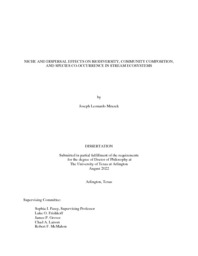
ATTENTION: The works hosted here are being migrated to a new repository that will consolidate resources, improve discoverability, and better show UTA's research impact on the global community. We will update authors as the migration progresses. Please see MavMatrix for more information.
Show simple item record
| dc.contributor.advisor | Passy, Sophia I | |
| dc.creator | Mruzek, Joseph Leonardo | |
| dc.date.accessioned | 2023-06-30T15:51:17Z | |
| dc.date.available | 2023-06-30T15:51:17Z | |
| dc.date.created | 2022-08 | |
| dc.date.issued | 2022-08-16 | |
| dc.date.submitted | August 2022 | |
| dc.identifier.uri | http://hdl.handle.net/10106/31448 | |
| dc.description.abstract | Niche and dispersal processes are major ecological drivers of freshwater communities but their relative roles across latitudinal gradients, scales, and organismal groups are not well understood. Thus, we performed three studies with sub-continental datasets of stream algae, insects, and fish. In chapter 2 we predicted that: i) niche processes would dominate at high latitudes due to increased climatic stress, consistent with the physiological tolerance hypothesis and the Dobzhansky-MacArthur hypothesis and ii) dispersal limitation would prevail at low latitudes due to narrower niches and smaller range sizes, consistent with the dispersal-ecological specialization tradeoff hypothesis, the latitude-niche breadth hypothesis, and Rapoport’s rule. Chapter 3 had two goals: i) compare the relative roles of niche and dispersal processes on metacommunity composition vs. topology of co-occurrence networks and ii) determine if the taxonomic relatedness between co-occurring taxa could be explained by shared niche preference or dispersal history. Chapter 4 investigated the role of spatial scale and dispersal ability on the relationship of local species richness (LSR) with regional species richness (RSR). A saturated LSR-RSR relationship indicates local control of local richness, whereas an unsaturated relationship indicates regional control through dispersal limitation. We predicted i) saturation at small scales due to habitat filtering, but a lack of saturation at large scales due to dispersal limitation and ii) that the less dispersive fish would shift from a saturated to unsaturated LSR-RSR relationship at a smaller scale than diatoms or insects. In summary, our findings contribute to community ecology by advancing our knowledge of the relative roles of niche and dispersal processes in controlling biodiversity, community composition, and network topology along environmental and spatial gradients. | |
| dc.format.mimetype | application/pdf | |
| dc.language.iso | en_US | |
| dc.subject | Algae | |
| dc.subject | Beta diversity | |
| dc.subject | Community ecology | |
| dc.subject | Co-occurrence network | |
| dc.subject | Dispersal limitation | |
| dc.subject | Environmental filtering | |
| dc.subject | Fish | |
| dc.subject | Insect | |
| dc.subject | Local species richness | |
| dc.subject | Regional species richness | |
| dc.title | Niche and dispersal effects on biodiversity, community composition and species co-occurrences in stream ecosystems | |
| dc.type | Thesis | |
| dc.contributor.committeeMember | McMahon, Robert F | |
| dc.date.updated | 2023-06-30T15:51:18Z | |
| thesis.degree.department | Biology | |
| thesis.degree.grantor | The University of Texas at Arlington | |
| thesis.degree.level | Doctoral | |
| thesis.degree.name | Doctor of Philosophy in Quantative Biology | |
| dc.type.material | text | |
| dc.creator.orcid | 0000-0002-8067-3824 | |
| local.embargo.terms | 2023-08-01 | |
| local.embargo.lift | 2023-08-01 | |
Files in this item
- Name:
- MRUZEK-DISSERTATION-2022.pdf
- Size:
- 3.239Mb
- Format:
- PDF
This item appears in the following Collection(s)
Show simple item record


